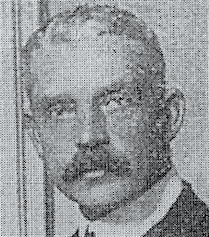
George Washington Browne [also known as Sir George Washington Browne] was born in Glasgow, Scotland on 21 September 1853 and was articled to Salmon, Son & Ritchie in Glasgow from c.1869 to 1873 [1]. He then worked as an assistant in the office of Campbell Douglas & Sellars from 1873 to 1875. In 1875 he moved to London and worked as an assistant to Stevenson & Robson from 1875 to 1877; and to Arthur William Blomfield (1829-1899) from 1877 to 1879. Whilst in the office of Blomfield, Browne was awarded the Pugin Studentship in 1877 [or 1878 - sources differ] enabling him to travel in France and Belgium. Following his return to London he worked briefly as an assistant in the office of William Eden Nesfield (1835-1888). In 1879 Browne returned to Scotland and worked as senior assistant to Robert Rowand Anderson (1834-1921) in Edinburgh until 1881.
In 1881 Anderson and Browne formed a partnership which became Anderson & Browne in 1883. They in turn merged with Wardrop & Reid in 1883 becoming Wardrop, Anderson & Browne. The partnership was dissolved in 1885. In 1895 or 1896 Browne formed a partnership with John More Dick Peddie (1853-1921). The partnership was dissolved in 1907. Browne then worked on his own on various random architectural commissions including several war memorials and the Y.M.C.A. Headquarters in Edinburgh (1916-18).
In addition to his work as an architect, Browne was also a painter and exhibited at the Royal Glasgow Institute of the Fine Arts, the Royal Scottish Academy in Edinburgh and the Royal Academy in London. He was elected an Associate of the Royal Scottish Academy (ARSA) in 1892, a full member of the Royal Scottish Academy (RSA) in 1902, and President of the Royal Scottish Academy (PRSA) in 1924. He was also an honorary member of the Royal Academy and the Royal Hibernian Academy. He was knighted in 1926.
Throughout his career as an architect Browne lived and worked in Scotland. In 1938 he moved to Wellington in Shropshire where he died on 15 June 1939.
A biographical file on George Washington Brown is available on request from the Enquiry Desk, Royal Institute of British Architects Library, London
____
[1] Note: The Directory of British Architects 1834-1914. Volume 1: A-K (2001 p.279) states that Browne was articled to John James Stevenson (1831-1908)
Notable among Browne's works were Central Station Hotel, Glasgow (1879); Stornoway Parish Church, Isle of Lewis (1884); St Margarets Episcopal Church, Biel, East Lothian (1884); United Presbyterian Church, Morningside (1886); Edinburgh Public Library (1887- 89); Redfern's Shop in Princes Street, Edinburgh (1892); Miss Cranston's Tea Rooms, 91 Buchanan Street, Glasgow (1897); Carnegie Library, Jedburgh, Scotland (1898); Caledonian Hotel, Lothian Road, Edinburgh (1899-1903); National Memorial to Edward VII at Holyrood, Edinburgh (1912–22); YMCA Building, St Andrew Street, Edinburgh (1914–15); numerous branches of British Linen Bank in Scotland (1890-1907); and Scottish war memorials - in Keith, Banffshire (1919); Lochearnhead (1920), Balquhidder (1920), Arbroath (1921), Dunfermline (1921), Duddingston, Edinburgh (1921), Coldstream (1922), and Montrose (1924)
_____
For a comprehensive list of Browne's architectural commissions see also:
Avery, Derek. Victorian and Edwardian Architecture. London: Chaucer Press, 2003
Directory of British Architects 1834-1914. Compiled by Antonia Brodie, et al. Volume 1: A-K. London; New York: British Architectural Library, Royal Institute of British Architects/Continuum, 2001
Gray, A. Stuart. Edwardian Architecture: a Biographical Dictionary. London: Gerald Duckworth & Co., Ltd., 1985
Mays, Deborah. ‘A profile of George Washington Browne’. Architectural Heritage, vol. 3, no. 1, 1992 pp. 52-63 [A special issue of Architectural Heritage entitled The Age of Mackintosh. Contains papers read at the conference Mackintosh’s Successful Contemporaries, organised by the Strathclyde Group of the Architectural Heritage Society and held in Glasgow in 1992]
‘Obituary’. The Builder 23 June 1939 p. 1187
‘Obituary’. Royal Institute of British Architects Journal 17 July 1939 p. 904
Who's Who in Architecture 1926. Edited by Frederick Chatterton. London: The Architectural Press, 1926